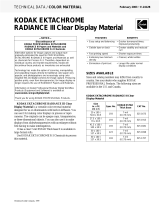Page is loading ...

Using KODAK Chemicals, Process E-6 • Z-119 Sixth Edition 12-1
12 VISUAL TROUBLESHOOTING
OF PROCESS E-6
Once you have eliminated improper film storage and incorrect exposure as causes of poor-quality transparencies on KODAK
EKTACHROME Film, check for processing problems. These problems include errors in chemical mixing, order of processing
steps, processing temperature, agitation, washing, replenishment, and solution contamination.
A visual check of the processed film is one way to make an initial diagnosis. You can make a more thorough determination of
the cause of processing problems and the corrective action to take by plotting and evaluating your control-strip densities; see
section 13, “Process Monitoring.”
Table 12-1
Troubleshooting from the Appearance of Processed Film
Appearance of Film Possible Cause
Very High Maximum
Density (very dark
no apparent image)
No Edgeprint
Visible
First developer omitted
Edgeprint
Visible
First developer and color developer reversed
Film not exposed
Dark Overall Inadequate time or low temperature in first developer
First or color developer diluted or exhausted
Color developer starter added to first developer
Too much first developer starter used
First developer or first and color developers underreplenished
Very Dark (overall or in random areas) Bleach or fixer (or both) omitted, reversed, diluted, exhausted, or underreplenished
LIght Overall Too much time or high temperature in first developer
Film fogged by light before processing
First or color developer (or both) too concentrated
First or color developer (or both) overreplenished
First developer starter omitted
First developer contaminated with reversal bath or color developer
First developer contaminated with fixer
Image Very Faint or No Image
(film may show colored streaks)
First developer used twice or color developer omitted
Severe light fog
Overall Density Variation from Batch to Batch Inconsistent first-developer time, temperature, agitation, or replenishment
Blue First developer contaminated with fixer
Reversal bath overconcentrated
Too little first developer starter used
Cyan First-wash temperature too low
Yellow Color-developer starter added to first developer
Too much first developer starter used
Inadequate bleaching or fixing
Yellow-Red First developer with color developer starter added
Underreplenishment of first developer or color developer
Low Density Blue; High Density Yellow Color developer contaminated with fixer
Green Reversal bath exhausted, diluted, or underreplenished
Film fogged by green safelight
Wash used between color developer and reversal bath
Color developer dilute
Color pH high
Too much Part A in color developer
Overreplenished color developer
A dilute color developer
Color developer mixed using first developer starter

12-2 Using KODAK Chemicals, Process E-6 • Z-119 Sixth Edition
Red Inadequate aeration of bleach
Pre-bleach concentration too high
Inadequate aeration of fixer
First-wash temperature too high
Severely oxidized color developer
Magenta Color developer pH low
Color developer concentrated
Too much Part B in color developer
Underreplenished color developer
Cross-Width Bar Marks (with stainless-steel reels) Gaseous-burst agitation used in first developer
Incorrect or inadequate manual agitation
Scum and Dirt
*
Bio-growth (slime) in final rinse (drain and replace)
Air filters in dryer need changing
Dirt in solutions; use floating covers on processor and replenisher solution tanks
Final rinse overconcentrated
Precipitate in pre-bleach
Dirt from dryer
Fixer sulfurized
Defoamer added directly to any solution or too much defoamer used
Surface Spots (appear dark by transmitted light) Dirt from final rinse
Water spotting. Final rinse too dilute
Dirt from dryer
Fixer sulfurized
Dryer temperature too high
Streaks—Nonuniformity Bleach or fixer time too short, temperature too low, or replenisher too dilute
Uneven or insufficient agitation, particularly in first and color developers
Nonuniform agitation in first and color developers
Low first-wash flow rate
Foam rundown
Scratches and Abrasions Dirty squeegee blades
Jammed, misaligned, or dirty rollers
Cinch marks due to excessive take-up tension
Dirt from loading area
Dirt from camera
Light Density Spots, Streaks, or Patterns Static
Fog
Stain Loss of bleach, fixer, or pre-bleach activity
Fixer sulfurized by excessive aeration
Bleach not sufficiently aerated
Color-developer time too long or temperature too high
Inadequate first-developer agitation
* A buildup of fungus or algae in processing solutions or wash tanks can cause dirt. To minimize buildup, drain wash tanks when they are not in use. When
you expect the processor to be out of use for more than six weeks, drain and rinse the reversal-bath processor tank and replenisher storage tanks. To remove
fungus or algae, scrub the tank with a stiff-bristle brush, using a 30 to 50 mL/L sodium hypochlorite solution (household bleach).
Rinse the tank thoroughly with water to remove all traces of the hypochlorite solution. Do not use a sodium hypochlorite solution in the wash tank that
follows the fixer. Use a 5- to 25-micrometre (or finer) filter for your water supply.
Appearance of Film Possible Cause
/
